MARKET OVERVIEW
The global carbapenem market is a significant sector of the pharmaceutical industry with a reputation for their role in combating bacterial infections. The business is leading the fight against microbial resistance by employing diverse range of potent antibiotic drugs. As the pharmaceutical industry is expanding, the global carbapenem market is expected to make substantial leaps in line with evolving healthcare needs and technology. Healthcare practitioners will be left with carbapenem antibiotics as the standard of care to combat multidrug-resistant organism-complicated severe infections, opening doors to effective patient outcomes and improved clinical practices. In addition, upcoming advances in technologies will be anticipated to draw the new trend of the global carbapenem market.
Technological advancements in formulation technology and drug delivery systems will be capable of improving the safety profile and efficiency of carbapenem antibiotics to enable usage by the various healthcare institutions. Moreover, ongoing research efforts towards the identification of novel carbapenem compounds with improved pharmacokinetic profiles and wide spectrum activity are likely to expand the application base of the market to treat a wider area of therapeutic needs. The worldwide carbapenem market is under the control of some of the major players, engaged in significant R&D efforts to expand their product range. These players would focus on strategic alliances, joint ventures, and acquisitions to expand their leadership status as well as geographical reach.
Moreover, continued investment in the manufacturing plants as well as regulatory backing will propel seamless supply chain and regulatory compliance, allowing continuous market growth. Geographically, the global carbapenem market will witness robust growth in emerging economies with the improvement in healthcare infrastructure development and higher awareness of infectious diseases. Emerging economies will witness high demand for carbapenem antibiotics with higher healthcare spending and a growing patient base. Market players will attempt to reap these benefits by structuring their product portfolio and marketing strategy to address local healthcare requirements and regulatory conditions. The global carbapenem market is packed with huge growth and innovation potential in the next few years.
Despite the growing antimicrobial resistance risk day by day, carbapenem antibiotics are most likely to retain pivotal significance in containing this public health risk. Owing to continuous innovation and technological developments and market shifts and realignments with strategies, the global carbapenem market may come to be the basis of next-generation infectious disease treatment that enables better health results for patients worldwide.
Global carbapenem market is estimated to reach $3,392.8 Million by 2032; growing at a CAGR of 5.3% from 2025 to 2032.
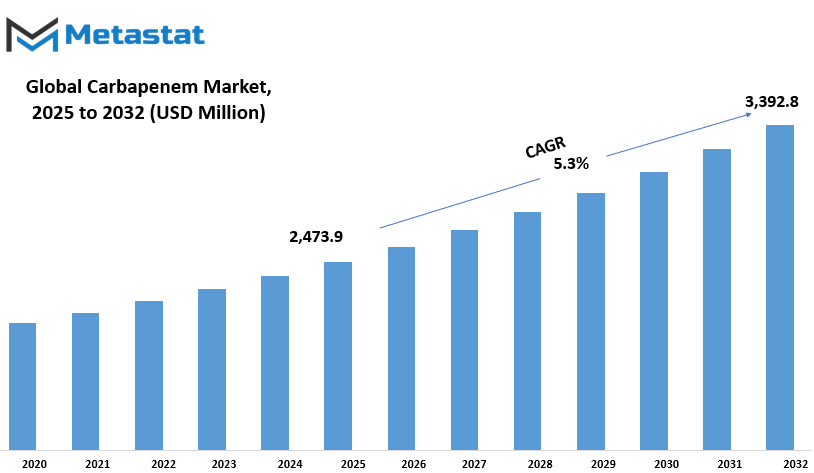
GROWTH FACTORS
The global carbapenem market is witnessing growing demand with rising rates of multidrug-resistant bacterial infections. This demand is led mainly by the demand for effective antibiotics such as carbapenems to manage these infections efficiently. Rising rates of health care-associated and complicated intra-abdominal infections further propel this demand.
There are, however, issues that might suppress the expansion of the carbapenem market. One of them is bacterial resistance to carbapenem as it may cause failure in treatment and reduce the efficacy of carbapenem therapy. It is a great risk to healthcare systems globally as it reduces the options for the treatment of bacterial infections.
In spite of these barriers, there is scope for innovation and growth in the carbapenem market. The discovery of new carbapenem products or combination products has the ability to overcome mechanisms of resistance and increase antibacterial activity. This will pave the way for the introduction of better drugs against bacterial infections, meeting unmet medical needs and thus propelling the expansion of the market.
In the coming two years, the carbapenem market will be witnessing profitable opportunities unrolling as a spinoff of research ingenuity in discovering antibiotics. Firms that are funding research and development in devising creative means of fighting antibiotic resistance will be witnessing profit opportunities in the form of growing demand for effective antibacterial treatment.
MARKET SEGMENTATION
By Type
Various forms of carbapenem have their existence in the global market, including Meropenem, Doripenem, Imipenem, Panipenem, Ertapenem, and many others. All of them are important and worth something in the market platform. Meropenem, for instance, was valued at 444.2 USD Million in 2020, indicating its widespread existence and demand. Doripenem, another form, was valued at 156.4 USD Million in the same year, indicating its importance in the market. Imipenem, at 383.6 USD Million, also speaks of its importance. Panipenem, at 125.0 USD Million, contributes to the diversity. Ertapenem, in various forms, expands the list of options for patients and doctors alike. The future of the world carbapenem market will see growth and expansion in larger numbers. The field of medical science and technology will further develop, always exploring the limits of creativity of antibiotic drugs like Carbapenems. Ongoing innovation in novel delivery systems and formulations, the efficacy and availability of Carbapenem medicines will be even greater, meeting evolving patient and healthcare system needs worldwide.
Apart from that, as the population of the world is increasing and aging, resistant pathogens and infectious diseases will rise. This will raise demand for potent antimicrobial drugs such as Carbapenems, which will help market growth. Furthermore, increased development of multidrug-resistant pathogens requires the production of new antibiotics, driving the market of Carbapenem ahead.
Apart from increasing healthcare spending, growing pharma infrastructure, and increased awareness of infectious diseases, will lead to the market growth. Healthcare organizations and governments will promote repeated prevention and control of infectious diseases, which will propel adoption of Carbapenem therapies.
The global carbapenem market includes regional types, which are assigned their value and importance; the market growth, spurred by increased medical research and development, will also call for Carbapenem therapies. Growth due to population growth, population aging, and the emergence of antibiotic-resistant bacterial infections will increase the size of the market. With ongoing investments and research in local antibiotics, Carbapenems will remain a significant component of infection disease therapy over the next few years.
By Application
The global carbapenem market which is key in the treatment of infections caused by bacteria is growing remarkably fast because of its multifactorial uses, such as Urinary Tract Infections, Bloodstream Infections, Intra-abdominal Infections, Pneumonia, and other applications therefore indicating a vast range of areas where Carbapenems are important in treating bacterial infections.
Urinary Tract Infections (UTIs) is one of the most impactful applications of Carbapenems. UTIs, which most commonly arise from bacteria infecting the urinary tract, and afterward the host may experience pain and other symptoms unless diagnosed and treated. Carbapenems exhibit broad-spectrum antibacterial activity and are utilized to manage severe cases of UTIs when other antibiotics are not working.
Bloodstream Infections, the second major application, are a health problem, where the bloodstream is typically infected by persistent organisms that are bacteria. Carbapenems can be very useful in this area since they cover a very wide range of bacteria that may be resistant to other drugs. They are very effective in these cases and are largely unbeatable in the hospital. Intra-abdominal Infections are also other intra-abdominal pathological bacterial infections, such as peritonitis and intra-abdominal abscesses.
|
Forecast Period |
2025-2032 |
|
Market Size in 2025 |
$2,473.9 million |
|
Market Size by 2032 |
$3,392.8 Million |
|
Growth Rate from 2025 to 2032 |
5.3% |
|
Base Year |
2024 |
|
Regions Covered |
North America, Europe, Asia-Pacific, South America, Middle East & Africa |
By Sales Channel
The global carbapenem market is witnessing significant growth, with projections indicating further expansion in the coming years. One key aspect contributing to this growth is the diverse range of sales channels through which Carbapenems are distributed and sold.
Currently, the market for Carbapenems is segmented based on various sales channels, including hospitals, clinics, and other outlets. These distinct channels play a crucial role in facilitating the availability and accessibility of Carbapenem drugs to consumers worldwide.
Hospitals serve as the primary sales channel for Carbapenems, accounting for a substantial portion of the market share. With the rising incidence of bacterial infections and the increasing demand for effective antibiotics in hospital settings, the sales of Carbapenems in this channel are expected to continue their upward trajectory.
The global carbapenem market is experiencing significant growth, and projections show that it will continue to grow in the future. One of the main drivers of this market growth is the various distinct sales channels it is sold and distributed through.
The now established carbapenem market divides itself into several sales channels: hospitals, clinics, and the still poorly understood other. These sales channels are critical, as they determine the availability of Carbapenem drugs to buyers around the world.
Hospitals are the primary sales channel for Carbapenems, representing a steady proportion of market share. The increase in the number of bacterial infections, and the demand for effective antibiotics in hospitals, suggests sales of Carbapenem will continue to grow in the hospital channel.
Clinics are another important sales channel for Carbapenem drugs. Clinics see a vast number of patients who require antibiotic treatment, including management of patients with some serious bacterial infection that require Carbapenem. While the provision of healthcare in clinics generally is still evolving, this allows for a reasonable assumption that the need for these powerful antibiotics will follow suit.
In addition to hospitals and clinics, Carbapenems can also be sold in other sales channels which fall under the broad category of "other". Other includes any form of sales outside of hospitals and clinics. This may involve, but not be limited to: online vendors, pharmacies, and specialty medical stores. By making these drugs available at other venues and outlets, consumers are able to acquire varous forms of Carbapenem drugs, create ease of availability, and build the growth of the market.
The global carbapenem market is experiencing strong growth. The sales channels facilitate access to the sale of these much needed antibiotics. As hospitals, clinics, and other venues continue to adapt to the changing healthcare needs of the populations across the globe, there will always be a high demand for Carbapenem drugs, thereby continuing the growth of the overall market in the upcoming years.
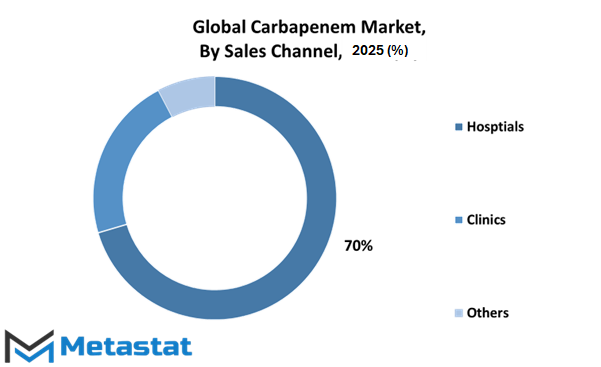
REGIONAL ANALYSIS
In the vast expanse of the pharmaceutical industry, the global carbapenem market stands as a pivotal player, offering solutions to bacterial infections that are increasingly resistant to other antibiotics. Geographically segmented, this market spans across continents, with North America, Europe, Asia-Pacific, South America, and Middle East & Africa each playing a unique role in its dynamics.
North America, with its advanced healthcare infrastructure and high prevalence of infectious diseases, will continue to be a significant contributor to the carbapenem market. The region's robust research and development activities, coupled with strong regulatory frameworks, will further bolster market growth.
Europe, renowned for its focus on innovation and technology in healthcare, will also play a key role in shaping the carbapenem market. With increasing awareness about the threat of antibiotic resistance and a growing elderly population susceptible to infections, the demand for Carbapenems is expected to rise steadily in this region.
Moving towards the dynamic Asia-Pacific region, rapid urbanization, and changing lifestyles will drive the demand for effective antibiotics like Carbapenems. Emerging economies such as China and India will witness significant market growth due to their large population bases and increasing healthcare expenditures.
The global carbapenem market is an important part of the larger pharmaceutical industry and provides a solution to bacterial infections that do not respond to other antibiotics. It is categorized geographically by region; including North America, Europe, Asia- Pacific, South America, and Middle East & Africa. Each of these regions has a unique set of socio-economic and environmental circumstances that affects the dynamic of the carbapenem market.
North America currently has the best healthcare infrastructure, with the highest prevalence of infectious diseases, and it will also be the most significant market for Carbapenem in the future. The region has a strong focus on research and development and is supported by significant statutory and regulatory frameworks to protect research and end-users from one another.
Europe will also help shape the growth of the carbapenem market, through its collective focus on innovation and the technology of the healthcare industry. The awareness and ongoing discussion about the threats of antibiotic resistance, and an aging population that is more likely to develop infections than younger counterparts, will ensure that there is steady growth in the demand for Carbapenem products.
As we move to the Asia-Pacific region, the increasing levels of urbanization and changing lifestyles create additional demand for effective antibiotics such as Carbapenems. Selected emerging or developing market opportunities, such as China and India, will expand because of population base, demand, and expending health care expenditures.
Across most of South America, growth of healthcare infrastructure and increasing healthcare funding will offer opportunities for the carbapenem market to expand in this region. From Brazil to Argentina, with the burden of infectious diseases, the use of powerful antibiotics like Carbapenems will increase as healthcare services continue to develop and grow.
In the Middle East & Africa, which face various healthcare challenges, the carbapenem market will also expand despite this. The local population ranging from various chronic conditions to the new emerging pandemic COVID-19 will allow to them increase healthcare funding to further increase the local healthcare system. With a growing population and also the increased cases of infectious diseases, it will be interesting to see if infectious disease is better managed.
As we begin to speculate what the future holds for the various regions for the global carbapenem market, we must understand too that advancement in healthcare technology, the regulatory environment and the burden of the disease will also change. To better understand the market on the whole next to the regional segmentations, each of the market segments face similar situations yet the differences between the local markets will continue to shape their dominance in their geographical regions.
The global carbapenem market is poised for growth and to be transformed across all regions, North America, Europe, Asia-Pacific, South America and the Middle East & Africa. Learning the nuances of each regional market and being able to adapt to what are most like to change in the market will put all the stakeholders in a position to take advantage of any opportunities. With the rising incidence of healthcare associated infections, the battle against antibiotic resistant infections is an important responsibility and a story on evolving innovation around the world.
COMPETITIVE PLAYERS
The global carbapenem market is witnessing significant growth, driven by various factors such as increasing incidences of bacterial infections, rising awareness about antibiotic resistance, and advancements in healthcare infrastructure. Key players in the Carbapenem industry, including Pfizer, Savior Lifetec, Sun Pharmaceutical Industries, and others, are actively contributing to the market's expansion.
One of the primary drivers of the carbapenem market is the escalating prevalence of bacterial infections worldwide. As bacterial pathogens continue to evolve and develop resistance against existing antibiotics, the demand for newer and more potent antibacterial agents like Carbapenems will rise. This trend is expected to persist in the future, leading to sustained growth in the carbapenem market.
Moreover, growing awareness among healthcare professionals and patients about the challenges posed by antibiotic resistance will further drive the adoption of Carbapenems. Antibiotic resistance has become a global health concern, threatening the effectiveness of various antibiotics and complicating the treatment of bacterial infections. In response to this challenge, healthcare providers are increasingly turning to Carbapenems as a reliable option for combating multidrug-resistant bacteria.
The carbapenem market is experiencing tremendous growth for many reasons and there is a major push to keep this growth cycle going based on various factors related to increasing incidences of bacterial infections, awareness of antibiotic resistance, and improvements in healthcare infrastructure. The Carbapenem players continuing to push avenues of growth in the market are high profile companies such as Pfizer, Savior Lifetec, Sun Pharmaceutical Industries, etc.
The increasing incidence of bacterial infections globally is a major growth driver in the carbapenem market. As bacterial pathogens change over time and demonstrate resistance to antibiotics, the need for newer, more effective antibacterial agents, such as Carbapenem compounds, will increase. This trend is expected to continue domain forever.
As healthcare professionals and patients continue to be made aware of the challenges of antibiotic resistance, the use of Carbapenem will grow. We have seen antibiotic resistance become a worldwide health problem threatening the efficacy of antibiotics and further complicating the treatment of bacterial pathogens. We have seen a shift by healthcare providers to take advantage of the efficacy of Carbapenem to combat multidrug resistant bacteria.
Additionally, improvements in healthcare infrastructure, especially in developing countries may drive growth in the carbapenem market. As countries continue to invest in building healthcare facilities, including greater access to essential medicines, Carbapenem demand is likely to see a rise. A greater focus on infection prevention and control in hospitals and other healthcare settings will also be beneficial for the carbapenem market growth. Along with research and development, some key players in the Carbapenem industry will engage in research and development to create new formulations and improve existing Carbapenem medications to innovate the pre-existing market, meet unmet medical needs and respond to new problems including antibiotic resistance.
As the global carbapenem market is likely to see continued growth due to eventually increased bacterial incidences, raised awareness of antibiotic resistance, and overall healthcare improvements which encourage the usage of Carbaenem drugs. The key players within the industry will create the market by initiating research and development initiatives and consistently supplying the market with drug demand for Carbapenems.
Carbapenem Market Key Segments:
By Type
- Meropenem
- Doripenem
- Imipenem
- Panipenem
- Ertapenem
- Others
By Application
- Urinary Tract Infections
- Bloodstream Infections
- Intra-abdominal Infections
- Pneumonia
- Others
By Sales Channel
- Hosptials
- Clinics
- Others
Key Global Carbapenem Industry Players
- Pfizer
- Savior Lifetec
- Sun Pharmaceutical Industries
- Kopran
- HISUN Pharmaceutical
- Shenzhen Haibin Pharmaceutical Co. Ltd.
- ACS Dobfar S.P.A.
- Daewoong Pharmaceutical Co.
- Iterum Therapeutics plc
- Lupin Imipenem
- Meiji Seika Pharma Co.
- Menarini Group
- Merck & Co.
- Spero Therapeutics
- Venus Remedies Ltd
WHAT REPORT PROVIDES
- Full in-depth analysis of the parent Industry
- Important changes in market and its dynamics
- Segmentation details of the market
- Former, on-going, and projected market analysis in terms of volume and value
- Assessment of niche industry developments
- Market share analysis
- Key strategies of major players
- Emerging segments and regional growth potential




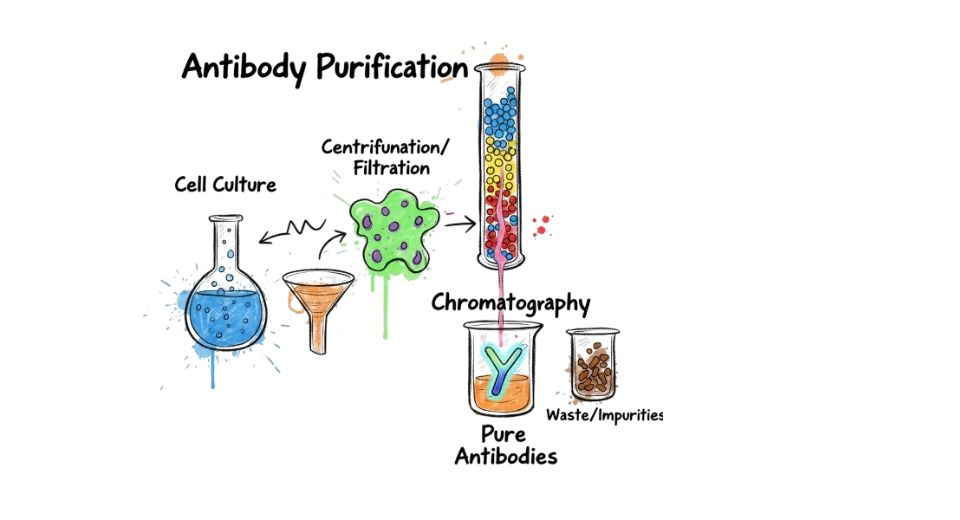
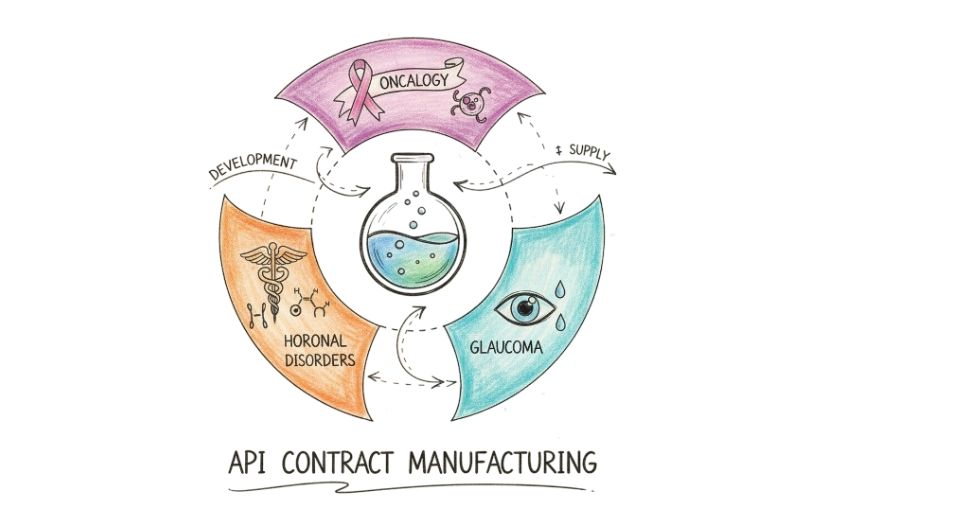
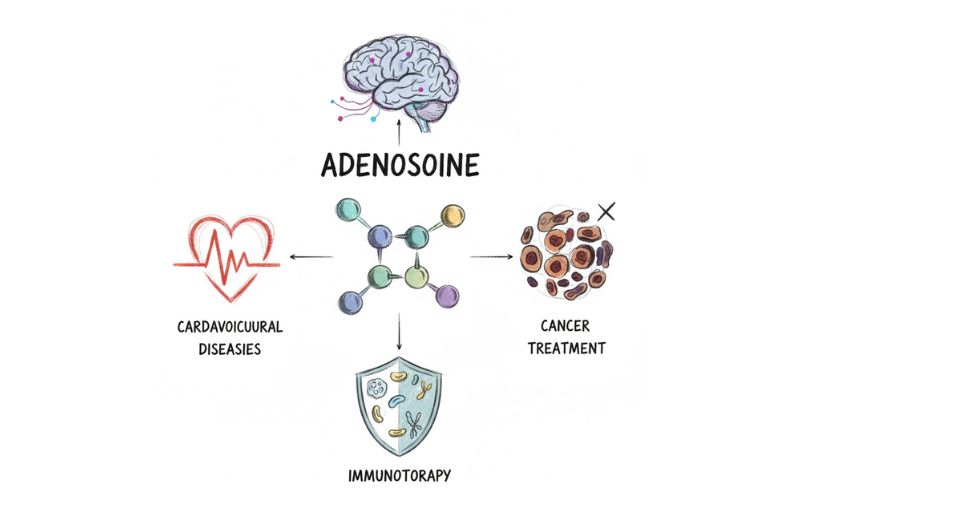

 US: +1 3023308252
US: +1 3023308252






